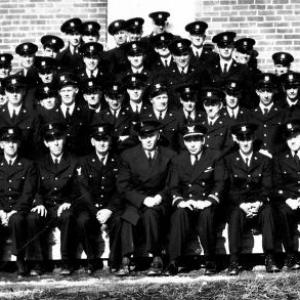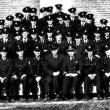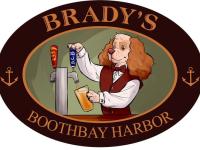Civilian Service in World War II, Part II
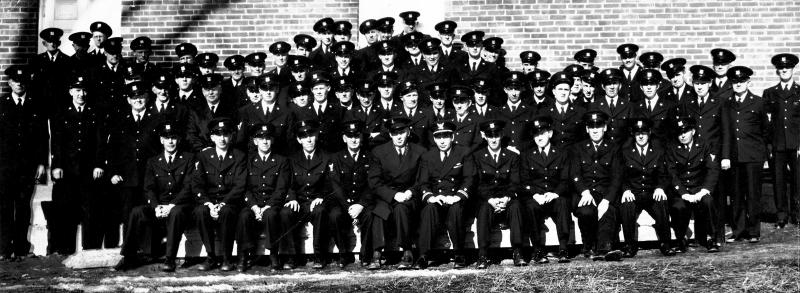 This 1943 or 1944 group photo of the local Coast Guard Auxiliary during World War II came from Chester Swett, a member of the wartime auxiliary. Some of the 69 men in the photo have been identified: Chester Swett, Warren Hume, Asa Tupper Sr., Asa Tupper Jr., Cliff Huskins, Frank Dunton, Mike Marshall, Drummond Giles, Lyman Pinkham, John Roberts, Miles Plummer Jr., and Buster Boyd. If anyone can identify others or wants a better look at the photo, call 633-0820 or visit the museum at 72 Oak Street on Thursdays, Fridays, or Saturdays from 10 a.m. to 2 p.m.
This 1943 or 1944 group photo of the local Coast Guard Auxiliary during World War II came from Chester Swett, a member of the wartime auxiliary. Some of the 69 men in the photo have been identified: Chester Swett, Warren Hume, Asa Tupper Sr., Asa Tupper Jr., Cliff Huskins, Frank Dunton, Mike Marshall, Drummond Giles, Lyman Pinkham, John Roberts, Miles Plummer Jr., and Buster Boyd. If anyone can identify others or wants a better look at the photo, call 633-0820 or visit the museum at 72 Oak Street on Thursdays, Fridays, or Saturdays from 10 a.m. to 2 p.m.
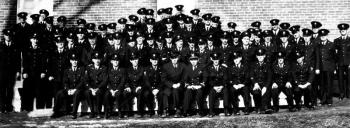 This 1943 or 1944 group photo of the local Coast Guard Auxiliary during World War II came from Chester Swett, a member of the wartime auxiliary. Some of the 69 men in the photo have been identified: Chester Swett, Warren Hume, Asa Tupper Sr., Asa Tupper Jr., Cliff Huskins, Frank Dunton, Mike Marshall, Drummond Giles, Lyman Pinkham, John Roberts, Miles Plummer Jr., and Buster Boyd. If anyone can identify others or wants a better look at the photo, call 633-0820 or visit the museum at 72 Oak Street on Thursdays, Fridays, or Saturdays from 10 a.m. to 2 p.m.
This 1943 or 1944 group photo of the local Coast Guard Auxiliary during World War II came from Chester Swett, a member of the wartime auxiliary. Some of the 69 men in the photo have been identified: Chester Swett, Warren Hume, Asa Tupper Sr., Asa Tupper Jr., Cliff Huskins, Frank Dunton, Mike Marshall, Drummond Giles, Lyman Pinkham, John Roberts, Miles Plummer Jr., and Buster Boyd. If anyone can identify others or wants a better look at the photo, call 633-0820 or visit the museum at 72 Oak Street on Thursdays, Fridays, or Saturdays from 10 a.m. to 2 p.m.
Last time, I described some local World War II civilian roles: carrying out black-outs, manning observation posts, and organizing and donating to fund drives for many war-related entities including war bonds and the Red Cross. This time I'll continue with other roles for the townspeople.
Most of the Boothbay Register's front page in those early 1940s war years was taken up with articles concerning the war, usually three across above the fold, extending below the fold, and continuing inside. Inside the honor roll listed who had enlisted; there were articles on where servicemen stateside were stationed and who was wounded, missing, or dead. Sprinkled throughout were home front war effort pieces. They covered new rules about rationing and other wartime measures, informational articles on food and other vital commodities, reports on how fund drives were doing, and long announcements of events and organizations' activities to support the war effort. Names of people organizing and taking roles in the groups were prominent, probably to encourage others to help. One of the biggest groups was the Citizens Service Corps.
Citizens Service Corps
The Civilian Defense Corps set up the formation of entities called Citizens Service Corps (CSC), of which Boothbay Harbor woman Fannie Perkins was the county head. There is a dizzying number of names of local entities, such as Civilian War Services and Protection Services, and I'm not sure of all their relationships. The Boothbay region's CSC, overseen by Mrs. Harold Dodge, was formed in April 1943 and consisted of at least 12 subcommittees: Consumer Interests, Social Protection and Child Welfare, Salvage, War Bonds, Nutrition (90% of local people pledged to have Victory Gardens), Recreation, Labor Supply and Training, Agriculture, War Housing, and the Neighborhood Plan.
The point was to help local men, women, and children understand what was needed and how they could be most useful to the war effort. Volunteers manned a room in the town office on McKown Street as a headquarters for information. Some of the opportunities: answering Civilian Defense telephones at the town office, delivering papers and objects, and guarding the pumping station and standpipe. The Neighborhood Plan was an interesting subcommittee. It divided the townspeople into groups of 10 to 12 families. They were all to serve in a chain to spread information and promote volunteering for the war effort. It's possible less than half the residents had a radio or a telephone so an organized network of contacts was needed.
With all the information and written forms that the Citizens Service Corps had to use or generate, I'm surprised nothing at all has come to the historical society. Mostly we have ration cards and stamps as the sole papers from World War II.
Coast Guard Auxiliary
In June 1942, a Coast Guard unit arrived and obtained housing on the By-Way. We're fortunate that John Foss gave us the sign for the unit's location on the Harbor waterfront. A year later the Coast Guard Auxiliary was formed, consisting initially of 50 men who served six-hour shifts each week. Their duties to assist the Coast Guard were patrolling and guarding the harbor and government facilities, as well as search and rescue, making deliveries to lighthouses, and enforcing waterborne rules of the road.
Asa Tupper, born 1898, gave us his file of correspondence, bills, and checking account records relating to his service as a boatswain's mate 1st Class in the auxiliary from July 1943 to July 1944. Evidently the required hours had climbed for he served 12 hours a week and as treasurer of Flotilla 208. a few sheets provided lists of about 75 men who paid for a manual for the auxiliary, thereby giving the names of many local members.
I learned a lot about mind-numbing bureaucracy through a string of 15 letters repeating an order for him to send original receipts to obtain reimbursement for a trip to Boston. He kept writing in turn to let them know he had sent them. Another bunch of papers covered in great detail the 45 pieces of clothing that he was issued, including two lapels, two undershirts, and one rating badge.
The local Coast Guard presence of 260 men on the waterfront ended in June 1944. By the time the Coast Guard Auxiliary's Flotilla 208 became inactive in September 1944, 105 local men had served almost 21,000 hours.
Rotary and Bluejackets Club
The Rotary took an active role in the war effort. Some of its activities: in November 1942 it sent Registers to every local man and woman in uniform; the following March it created storefront displays of photos of men and women in uniform; and in fall 1943 it sent 425 Christmas boxes to those in the service, filled with donated gifts "from all of us for all of them."
There were other efforts to help the servicemen closer at hand. In June 1942 the Bluejackets Club, a recreation center for servicemen stationed here, was formed. It was at two locations on the By-Way, then moved again to Townsend Avenue across from McClintock Street. The region women, chaired by Ethel Logan, manned it with snacks, magazines, games, and so on. I read all of Bess Reed's 60 years of diaries, and she devoted quite a bit of time to the club. She lived at the historical society and would have one or two servicemen in for dinners often. In June 1944, the Bluejackets Club closed after two years.
A future article will cover the matter of sabotage and the newspaper's attention to the servicemen: their letters, poems, and news.
Event Date
Address
United States

